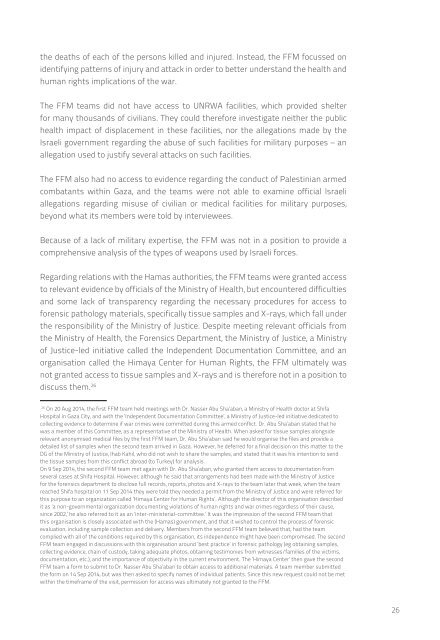HHo0s
HHo0s
HHo0s
You also want an ePaper? Increase the reach of your titles
YUMPU automatically turns print PDFs into web optimized ePapers that Google loves.
the deaths of each of the persons killed and injured. Instead, the FFM focussed onidentifying patterns of injury and attack in order to better understand the health andhuman rights implications of the war.The FFM teams did not have access to UNRWA facilities, which provided shelterfor many thousands of civilians. They could therefore investigate neither the publichealth impact of displacement in these facilities, nor the allegations made by theIsraeli government regarding the abuse of such facilities for military purposes – anallegation used to justify several attacks on such facilities.The FFM also had no access to evidence regarding the conduct of Palestinian armedcombatants within Gaza, and the teams were not able to examine official Israeliallegations regarding misuse of civilian or medical facilities for military purposes,beyond what its members were told by interviewees.Because of a lack of military expertise, the FFM was not in a position to provide acomprehensive analysis of the types of weapons used by Israeli forces.Regarding relations with the Hamas authorities, the FFM teams were granted accessto relevant evidence by officials of the Ministry of Health, but encountered difficultiesand some lack of transparency regarding the necessary procedures for access toforensic pathology materials, specifically tissue samples and X-rays, which fall underthe responsibility of the Ministry of Justice. Despite meeting relevant officials fromthe Ministry of Health, the Forensics Department, the Ministry of Justice, a Ministryof Justice-led initiative called the Independent Documentation Committee, and anorganisation called the Himaya Center for Human Rights, the FFM ultimately wasnot granted access to tissue samples and X-rays and is therefore not in a position todiscuss them. 2626On 20 Aug 2014, the first FFM team held meetings with Dr. Nasser Abu Sha’aban, a Ministry of Health doctor at ShifaHospital in Gaza City, and with the ‘Independent Documentation Committee’, a Ministry of Justice-led initiative dedicated tocollecting evidence to determine if war crimes were committed during this armed conflict. Dr. Abu Sha’aban stated that hewas a member of this Committee, as a representative of the Ministry of Health. When asked for tissue samples alongsiderelevant anonymised medical files by the first FFM team, Dr. Abu Sha’aban said he would organise the files and provide adetailed list of samples when the second team arrived in Gaza. However, he deferred for a final decision on this matter to theDG of the Ministry of Justice, Ihab Kahil, who did not wish to share the samples, and stated that it was his intention to sendthe tissue samples from this conflict abroad (to Turkey) for analysis.On 9 Sep 2014, the second FFM team met again with Dr. Abu Sha’aban, who granted them access to documentation fromseveral cases at Shifa Hospital. However, although he said that arrangements had been made with the Ministry of Justicefor the forensics department to disclose full records, reports, photos and X-rays to the team later that week, when the teamreached Shifa hospital on 11 Sep 2014 they were told they needed a permit from the Ministry of Justice and were referred forthis purpose to an organization called ‘Himaya Center for Human Rights’. Although the director of this organisation describedit as ‘a non-governmental organization documenting violations of human rights and war crimes regardless of their cause,since 2002,’ he also referred to it as an ‘inter-ministerial-committee.’ It was the impression of the second FFM team thatthis organisation is closely associated with the (Hamas) government, and that it wished to control the process of forensicevaluation, including sample collection and delivery. Members from the second FFM team believed that, had the teamcomplied with all of the conditions required by this organisation, its independence might have been compromised. The secondFFM team engaged in discussions with this organisation around ‘best practice’ in forensic pathology (eg obtaining samples,collecting evidence, chain of custody, taking adequate photos, obtaining testimonies from witnesses/families of the victims,documentation, etc.), and the importance of objectivity in the current environment. The ‘Himaya Center’ then gave the secondFFM team a form to submit to Dr. Nasser Abu Sha’aban to obtain access to additional materials. A team member submittedthe form on 14 Sep 2014, but was then asked to specify names of individual patients. Since this new request could not be metwithin the timeframe of the visit, permission for access was ultimately not granted to the FFM.26


